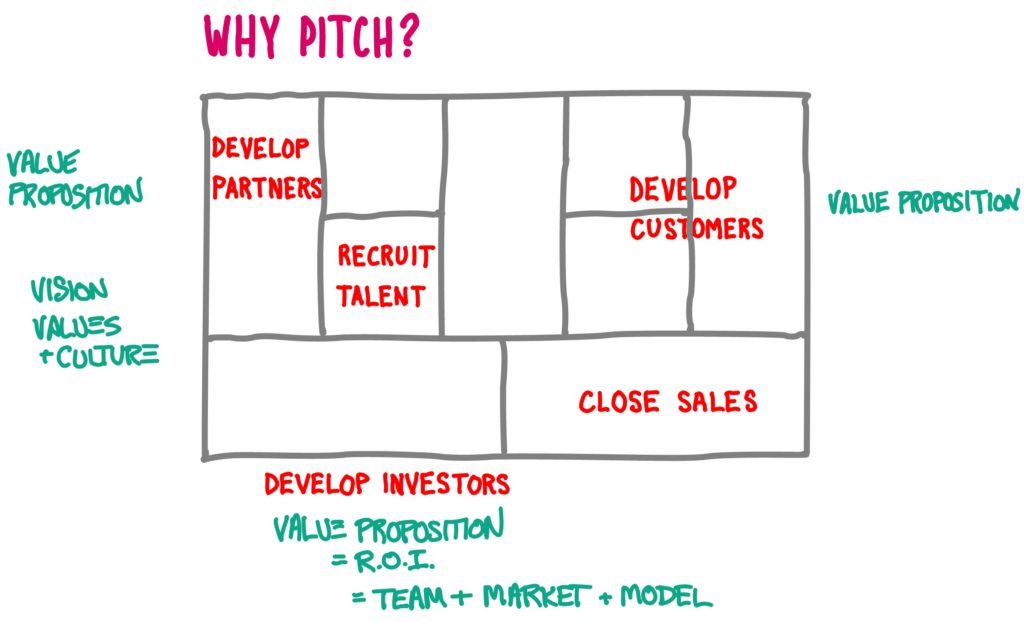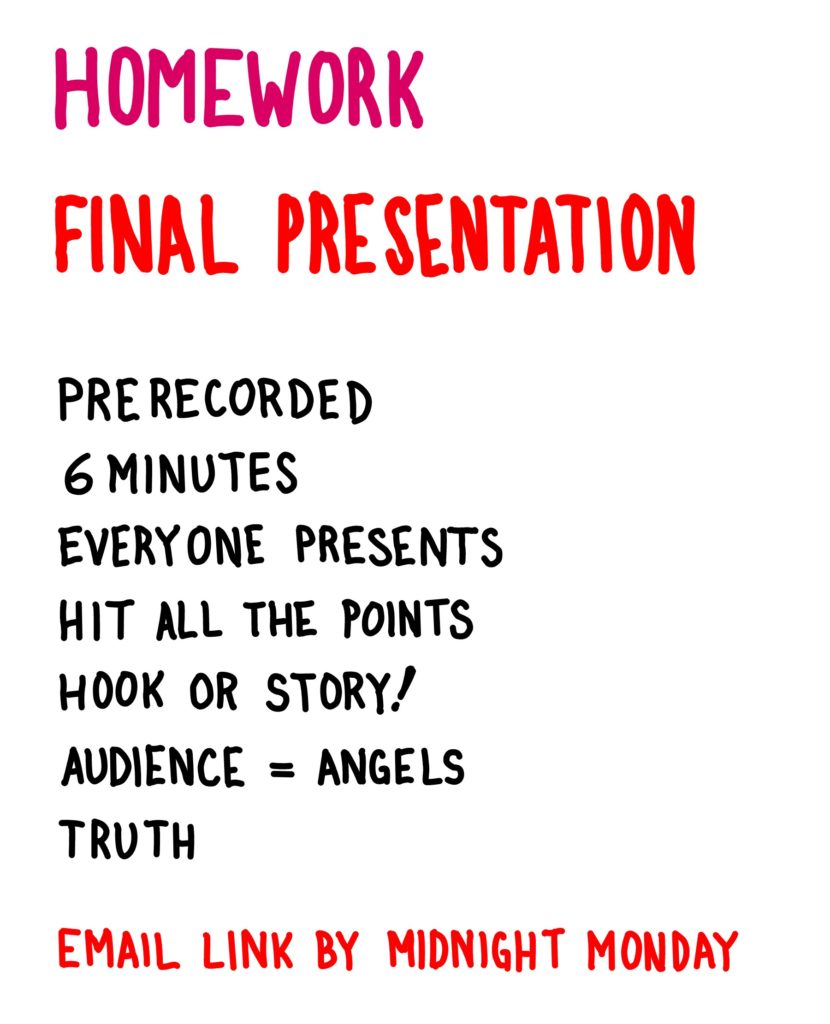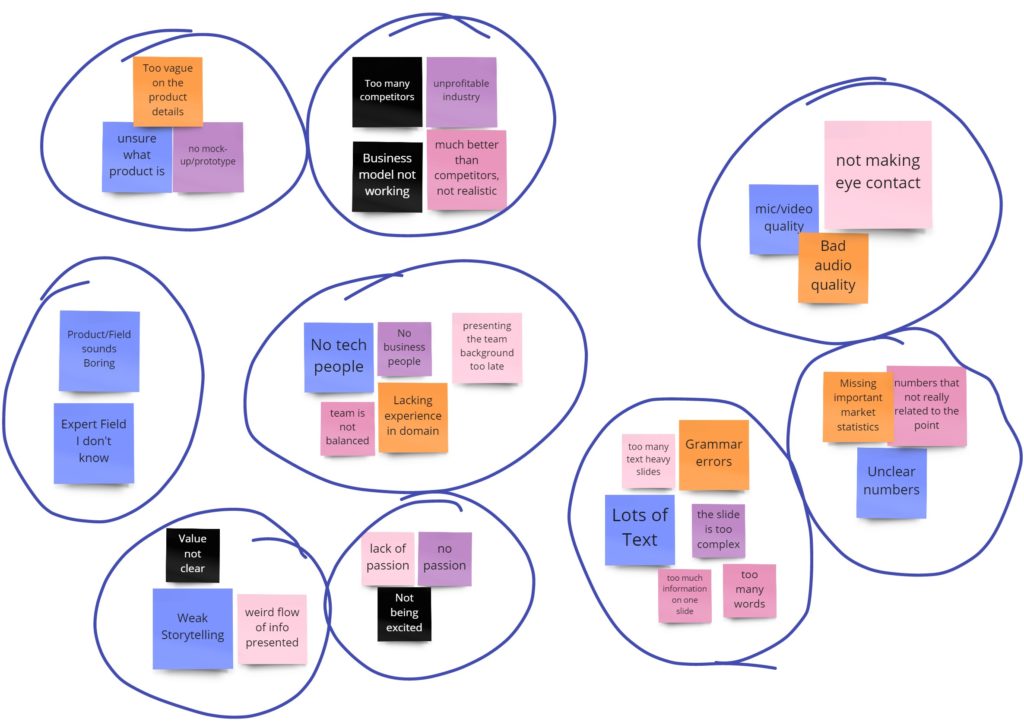As a company leader, you are constantly pitching your company and products. The style and content of the pitch changes (obviously) based on the audience.

Investor pitches are the most difficult because they are dense with information – if you are successful, your audience should:
- care about the problem you are solving,
- be excited about your unique solution,
- believe this is the best team to solve this problem,
- understand the market opportunity for your product,
- understand the competitive landscape for solutions to the problem you are addressing,
- know what your company does in every block of the Business Model Canvas, and
- know what you are asking them to do for you.
Easy, right?
In class exercise
We analyzed pitches done for CMU Swartz Center’s 2021 McGinnis Venture Competition. To begin, everyone added notes to a Miro board about topics covered in presentations they watched. The notes were then grouped by emerging topics.
We then did the same exercise with answers to the question, “What did they do to capture your attention and keep your interest?“.
And we did the same with, “What did they do that was distracting or made you lose confidence in them?“.
Review

A pitch for investors needs to cover all this information. The order depends on how you want to tell your story, and what information you think the audience needs first.

Entertainment products aren’t necessarily solving a problem for their audience, so a pitch needs to tell this part of the story differently. The goal is the same however – help your audience understand why users will clamor to get your product.
Pitches that march through a list of topics are tedious and dull. Stories engage the audience and keep them wondering what’s next. Finding a hook at the beginning will grab their attention, but you still need a story thread to weave through the rest of the presentation.
Investors are betting on the team as much as they are the product idea. Pitches are your first chance to make an impression, so how you present yourself, your company, and your content will have an enormous impact on the outcome of your efforts.
Homework
The Set Up
EET’s final presentations are modeled after Demo Days that accelerators host. Historically, these events have happened in a theatre or large meeting room with a parade of startups giving live presentations in front of projected Powerpoint decks.
COVID changed all that.
In 2020 and 2021, Demo Days have gone virtual. I believe this will continue. In person events won’t disappear, but the major events will be streaming to attract a wider audience, and to support startups with geographic diversity. Online pitches will become the norm rather than the exception. In this new styling, presentations can be pre-recorded, with Q&A and virtual meetups happening live online.
This class is going to join that world. This semester, final presentations will be pre-recorded and played during class, followed by a Q&A session, discussion, and a critique.
What you need to do

Clarifications and Some Pointers
The bar for quality is set at a Zoom recording. You can have your team do it once and record it. You can go beyond that if you want by having team members record their parts individually (using webcams, phone cameras, DSLRs, or video cameras) and edit them together. It is NOT a requirement that you make a high end video production out of this.
Even if you are using your laptop to record on Zoom, pay attention to the video and audio quality. Make sure your scene is lit well (as simple as sitting by soft window light) to avoid silhouettes or harsh shadows on faces. Get good audio – being close to the mic makes a huge difference in reducing background noise and echo. If you have iPods or equivalent earpieces or headphones with mics they will give you much better audio than a laptop at arms distance.
Balance the text on your slides with where you want your audience to pay attention, use graphics where possible to support your point. It’s okay to go full screen on the speaker if that helps deliver your message.
Review back to what you thought worked well or poorly in the other presentations you reviewed, and take advantage of that knowledge.


